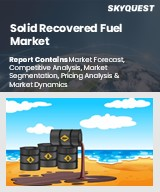
세계의 고형 폐기물 연료 시장 규모는 2023년에 49억 달러로 평가되며, 2024년 52억 1,000만 달러에서 2032년에는 85억 6,000만 달러로 성장하며, 예측 기간(2025-2032년)의 CAGR은 6.4%로 성장할 전망입니다.
고형 폐기물 연료(SRF) 시장은 친환경 규제 강화와 지속가능한 에너지 솔루션으로의 전환으로 인해 전 세계에서 큰 성장세를 보이고 있습니다. 재활용이 불가능한 폐기물을 활용하는 SRF는 특히 시멘트 생산과 에너지 생산에서 화석연료를 대체할 수 있는 대안으로 떠오르고 있습니다. 처리 기술의 발전으로 SRF의 품질과 신뢰성이 향상되어 매립지 사용과 탄소 배출을 최소화하고자 하는 산업계에 매력적인 선택이 되고 있습니다. SRF에 대한 수요가 증가함에 따라 기업은 생산 방식을 개선하고 통합 공급망에 투자하고 있습니다. 그러나 이러한 성장에는 환경 안전, 규제 준수, 사회적 인식에 대한 과제가 있으며, 엄격한 모니터링과 투명성이 필요합니다. SRF가 에너지 안보와 폐기물 관리에서 그 잠재력을 발휘하기 위해서는 이러한 요소들의 균형을 맞추는 것이 필수적입니다.
Global Solid Recovered Fuel Market size was valued at USD 4.9 billion in 2023 and is poised to grow from USD 5.21 billion in 2024 to USD 8.56 billion by 2032, growing at a CAGR of 6.4% during the forecast period (2025-2032).
The solid recovered fuel (SRF) market is experiencing significant growth, driven by rising environmentally friendly regulations and a global shift towards sustainable energy solutions. Utilizing non-recyclable waste, SRF is emerging as a viable alternative to fossil fuels, particularly in cement production and energy generation. Advances in processing technologies have enhanced SRF's quality and reliability, making it an attractive option for industries seeking to minimize landfill use and carbon emissions. As demand for SRF escalates, companies are investing in improved production methods and integrated supply chains. However, this growth presents challenges related to environmental safety, regulatory compliance, and public perception, necessitating stringent monitoring and transparency. Balancing these factors will be essential for SRF to fulfill its potential in energy security and waste management.
Top-down and bottom-up approaches were used to estimate and validate the size of the Global Solid Recovered Fuel market and to estimate the size of various other dependent submarkets. The research methodology used to estimate the market size includes the following details: The key players in the market were identified through secondary research, and their market shares in the respective regions were determined through primary and secondary research. This entire procedure includes the study of the annual and financial reports of the top market players and extensive interviews for key insights from industry leaders such as CEOs, VPs, directors, and marketing executives. All percentage shares split, and breakdowns were determined using secondary sources and verified through Primary sources. All possible parameters that affect the markets covered in this research study have been accounted for, viewed in extensive detail, verified through primary research, and analyzed to get the final quantitative and qualitative data.
Global Solid Recovered Fuel Market Segments Analysis
Global Solid Recovered Fuel Market is segmented by Waste Type, Application, Grade and region. Based on Waste Type, the market is segmented into Biodegradable, Recyclable, Composite and Inert Waste. Based on Application, the market is segmented into Cement Plants, Lime Plants, Coal-Fired Power Plants and Combined Heat and Power (CHP) Facilities. Based on Grade, the market is segmented into Low and High. Based on region, the market is segmented into North America, Europe, Asia Pacific, Latin America and Middle East & Africa.
Driver of the Global Solid Recovered Fuel Market
The Global Solid Recovered Fuel market is significantly driven by an increasing emphasis on sustainable waste management practices worldwide. Many governments are implementing more rigorous regulations aimed at reducing landfill usage while promoting waste-to-energy alternatives. These regulations often include incentives that encourage the diversion of municipal and industrial waste from landfills towards energy recovery processes, positioning solid recovered fuel as a pivotal solution. By converting non-recyclable waste into high-calorific fuel, cement and power plants can effectively reduce their environmental footprints and comply with regulatory standards, further enhancing the appeal and demand for solid recovered fuel in the energy sector.
Restraints in the Global Solid Recovered Fuel Market
The Global Solid Recovered Fuel market faces significant challenges due to stringent regulations surrounding emission standards and quality control. Achieving the desired calorific value, moisture content, and chlorine levels in SRF can be both costly and difficult, limiting accessibility. Consumers of SRF are obligated to adhere to rigorous emission guidelines to prevent the release of harmful pollutants during combustion, which adds further complexity to the operational process. These technical and regulatory hurdles elevate operational costs and complicate supply chain management, ultimately restricting the utilization of SRF across specific industries and geographical regions.
Market Trends of the Global Solid Recovered Fuel Market
The Global Solid Recovered Fuel (SRF) market is witnessing a significant upward trend, primarily driven by the cement sector's escalating demand for sustainable energy sources. As the cement industry seeks to reduce its carbon footprint amidst growing environmental concerns, it has increasingly turned to SRF, which is generated mainly from construction and demolition waste. Concurrently, the expansion of waste-to-energy facilities worldwide has further augmented the consumption of SRF, positioning it as a viable alternative to fossil fuels. Advances in waste treatment technologies have improved SRF's fuel quality, enabling industries to comply with stringent environmental regulations while maintaining cost efficiency in energy usage.